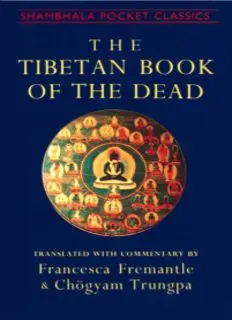
The Tibetan Book of the Dead. The Great Liberation Through Hearing in the Bardo PDF
Preview The Tibetan Book of the Dead. The Great Liberation Through Hearing in the Bardo
TH E TIBETAN BOOK OF THE DEAD The Great Liberation through Hearing in the Bardo by GURU RINPOCHE according to KARMA-LINGPA Translated with commentary by Francesca Fremantle &CHOGYAtM TRUNGPA SHAMBHALA Boston 4c London 1992 Shambhala Publications, Inc. Horticultural Hall 300 Massachusetts Avenue Boston, Massachusetts 0211 £ h ttp://www. shambhala. com © *97£ by Francesca Fremantle and Chogyam Trungpa, © 1992 by Francesca Fremande and Diana Mukpo All rights reserved. No part of this book may be reproduced in any form or by any means, electronic or mechanical, including photocopying, recording, or by any information storage and retrieval system, without permission in writing from the publisher. 9 8 7 6 5 Printed in Canada @ This edition is printed on acid-free paper that meets the American National Standards Institute Z39.48 Standard. Distributed in the United States by Random House, Inc., and in Canada by Random House of Canada Ltd Cover art: Mandala of Samantabhadra, Supreme Buddha. © Musees Nationaux (Musee Guimet, Paris). See page 257 for Library of Congress Cataloging-in-Publication Data. isbn 0-87773-675-8 lc 91-£°798 CONTENTS Editor’s Note vi Foreword by Chogyam Trungpa vii Introduction by Francesca Fremantle xi Commentary by Chogyam Trungpa i The Tibetan Book of the Dead js Inspiration-Prayers 229 Notes 251 EDITOR’S NOTE T his Shambhala Pocket Classics edition of The Tibetan Book of the Dead is a re printing of the Shambhala Dragon Edition of the same tide and includes the complete translation of the Bardo Thotrol, the original introduction by Francesca Fremande, the full commentary by Chogyam Trungpa, the “Inspirational Prayers,” and notes. The pronunciation key, glossary, bibliography, and index have been omitted. vi FOREWORD The Bardo Thotrol (Bar-do’i-thos-grol) is one of a series of instructions on six types of liberation: liberation through hearing, liberation through wearing, liber ation through seeing, liberation through remembering, liberation through tasting, and liberation through touching. They were composed by Padmasambhava and written down by his wife, Yeshe Tsogyal, along with the sadhana of the two man- dalas of forty-two peaceful and fifty-eight wrathful deities. Padmasambhava buried these texts in the Gampo hills in central Tibet, where later the great teacher Gampopa estab lished his monastery. Many other texts and sacred objects were buried in this way in different places throughout Tibet, and are known as terma, “hidden treasures.” Pad- vii FOREWORD masambhava gave the transmission of power to discover the termas to his twenty-five chief disciples. The Bardo texts were later discovered by Karma-Lingpa, who was an incarnation of one of these disciples. Liberation, in this case, means that whoever comes into contact with this teaching—even in the form of doubt, or with an open mind—receives a sudden of enlightenment through the power of the transmission contained in these treasures. Karma-Lingpa belonged to the Nyingma tradition but his students were all of the Kagyii tradition. He gave the first trans mission of the six liberation teachings to Dodiil-Dorje, the thirteenth Karmapa, who in turn gave it to Gyurme-Tenphel, the eighth Trungpa. This transmission was kept alive in the Surmang monasteries of the Trungpa lineage, and from there it spread back into the Nyingma tradition. viii FOREWORD The student of this teaching practices the sadhana and studies the texts so as to become completely familiar with the two mandalas as part of his own experience. I received this transmission at the age of eight, and was trained in this teaching by my tutors, who also guided me in dealing with dying people. Consequently I visited dying or dead people about four times a week from that time onwards. Such con tinual contact with the process of death, particularly watching one’s close friends and relatives, is considered extremely im portant for students of this tradition, so that the notion of impermanence becomes a living experience rather than a philo sophical view. This book is a further attempt to make this teaching applicable to students in the West. I hope that the sadhana may also be translated in the near future, so that this tradition may be fully carried out. CHOGYAM TRUNGPA, Rinpoche ix INTRODUCTION By coincidence, this introduction was written at Riimtek Monastery in Sik kim, looking across the valley to Gangtok where, half a century ago, Kazi Dawa- Samdup translated and W. Y. Evans-Wentz edited the first English version of the Bardo Thotrol. A further link with them is pro vided by the fact that this new translation appeared as part of a series dedicated to Evans-Wentz. Since their work is so widely known and has been the cause of so much interest in Buddhism, it may be asked why there is any need for a new version. Evans-Wentz himself gives part of the answer in his own Introduction, where he recognizes “the pi oneer character of the work.” Since then, especially after the flight from Tibet of many of the highest lamas, information xi
